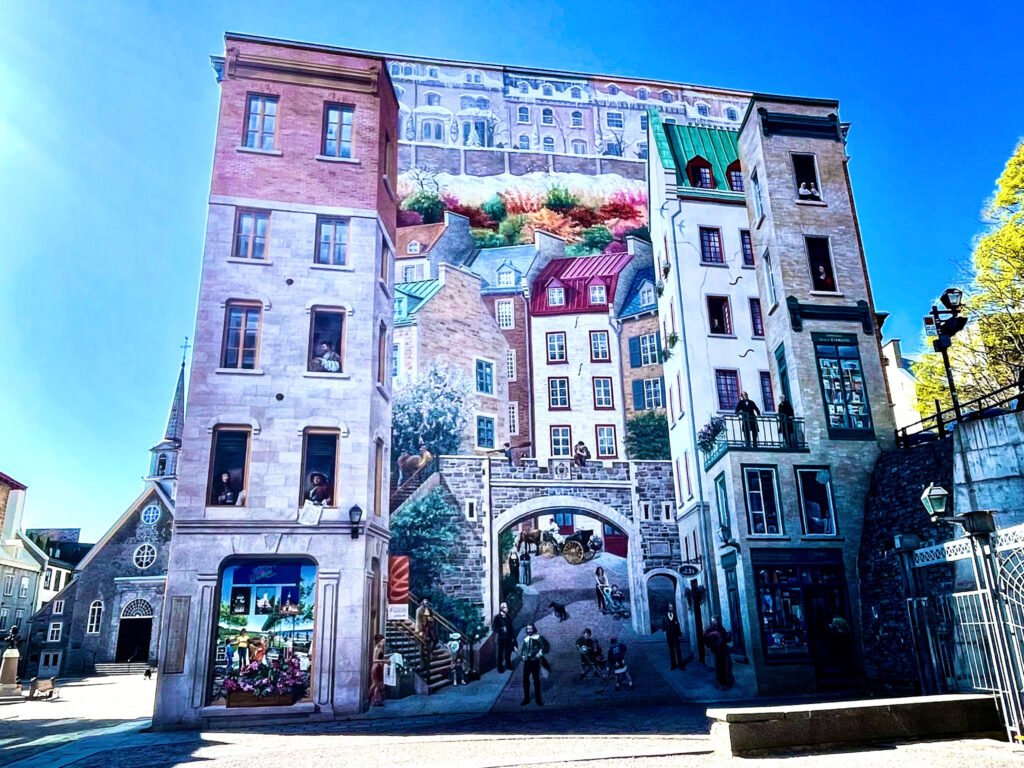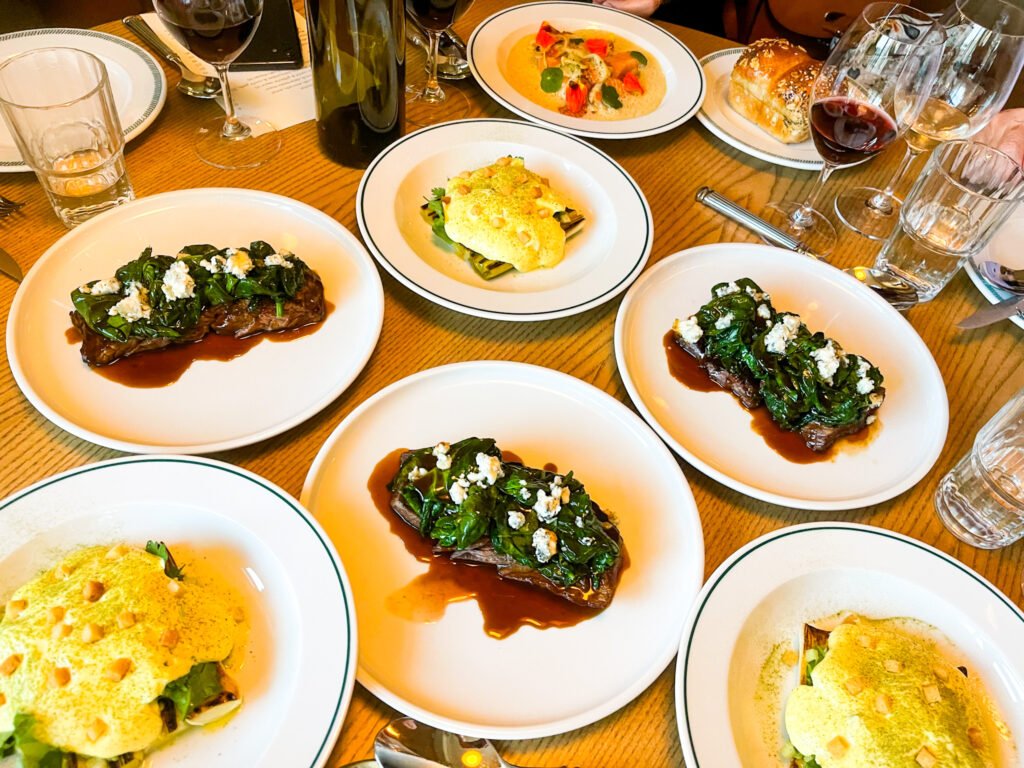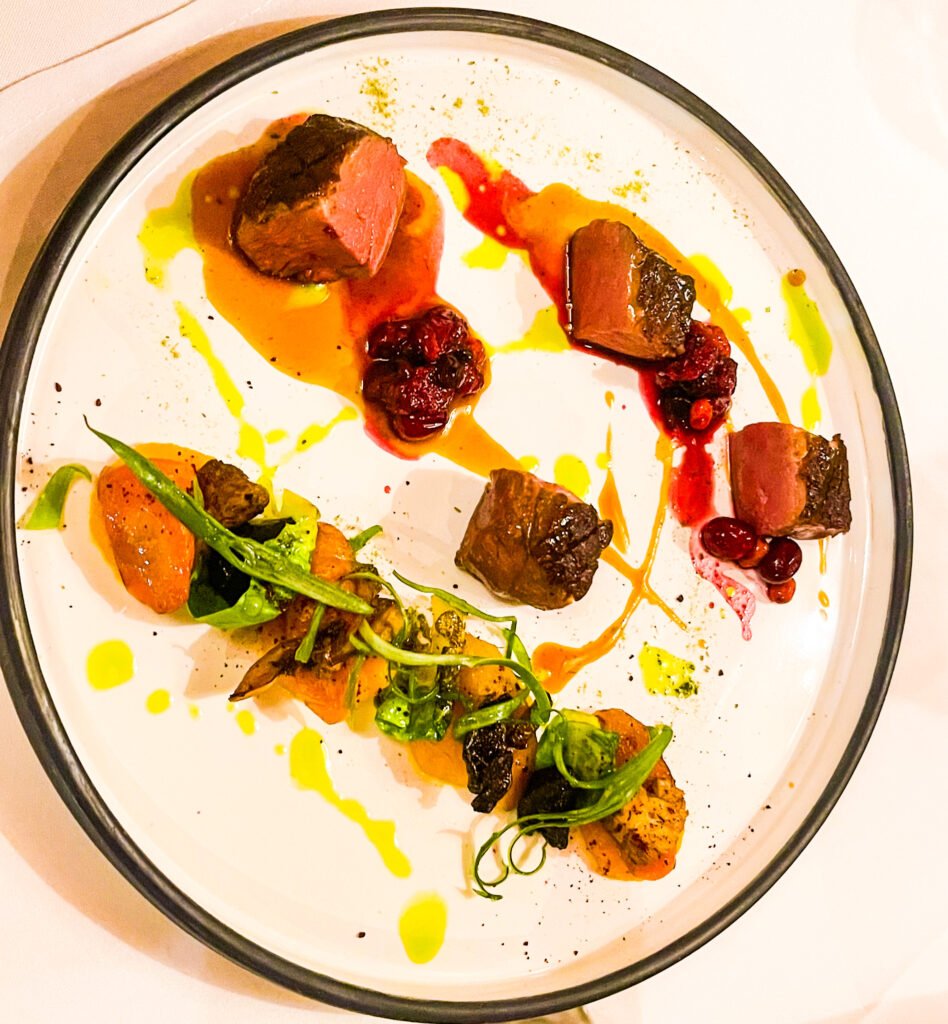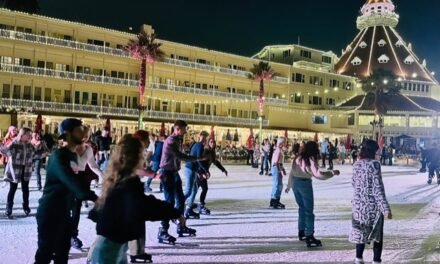
A French Holiday: Dining and Lodging in Québec City

Québec City is North America’s oldest French-speaking city. First settled in 1535 (by explorer Jacques Cartier) as a fur-trading settlement, it is perched high on the north bank of the Saint-Lawrence River with sweeping views of the Laurentian Mountains. The gorgeous enclave was formally established in 1608 by Samuel de Champlain. Its early history reflects Europe’s Anglo-French conflicts of the 17th and 18th centuries, and even after France ceded “New France” to Britain in 1763 following the Seven Years’ War, the region has always remained staunchly French.
In 1985, historic Québec was named a UNESCO World Heritage site. Its ramparts, bastions, and gates make it the only walled North American city north of Mexico. Condé Nast readers rank it in the top 20 culinary cities in the world. Quebec’s February Winter Carnival attracts nearly 400,000 people and is the largest winter festival in the world.
Picturesque cobblestone streets captivate visitors in any season, but springtime is exceptional. Flowers bloom in city parks as days turn longer and winter snowdrifts slowly melt. Crowds are spare and temperatures are mild. Best of all, March and April are maple syrup season, when cabanes à sucre (“sugar shacks”) in the city and surrounding woods rejoice in the harvest of the celebrated sap. Syrup is poured on every dish as Quebecers feast and dance to local music.

Located within the walls of Old Québec, is the cities iconic Fairmont Le Château Frontenac. With sweeping views of the St. Lawrence River it’s central locale is best for discovering Quebec City

Vibrant frescoes on the sides of buildings in Old Quebec, tell tales of the regions rich history

Chef Dominique Jacques, winner of the “Les Chefs” Canadian TV competition, is one of many innovated young chefs transforming the culinary landscape
Behind the massive walls of the fortified city, alluring Rue de Petit-Champlain, perhaps North America’s oldest street, dates back to the 17th century. Charming boutiques and lively restaurants line cobbled lanes. Locals and tourists alike stop to watch buskers and performing artists. “I have the best retirement plan in the world,” said an elderly gentleman, playing his violin for any who cared to listen.
A wide range of museums are located within the tantalizing “Walled City.” The Museum of Civilization chronicles the heritage of New France. If your interests drift to indigenous culture or military history, there’s something here for you, too.
AN EPICUREAN JOURNEY
A food-critic colleague told me that Québec City is becoming known as the gastronomic capital of Canada. Quebecers, she said, are foodies, and the city has an army of brilliant young chefs who use locally sourced ingredients in their sustainably oriented restaurants.
Intrigued, I asked for dining recommendations. These restaurants topped the list:

Chefs Alexandra Roy, Charles Provencher-Proulx, Guillaume Saint-Pierre have joined together to open Melba; a new restaurant in the Saint-Sauvuer district of Quebec City


Chez Rioux & Pettigrew: Located in the old port in a building that housed the Rioux & Pettigrew general store in the 1860s, R&P is a popular rendezvous point. It features 19th-century art, beautiful brick walls and oversized windows that overlook the green spaces on vibrant Rue Saint-Paul. Chef Dominique Jacques, winner of the “Les Chefs” Canadian TV competition, has transformed the dwelling from a wholesale grocer to a European-style bistro.
Jacques’ seasonal menu, sourced from artisanal vendors throughout Québec, includes such favorites as roasted lamb with corn salsa-fried polenta, and blood pudding is always on the menu. The Rioux & Pettigrew Experience is a four-course tasting menu that highlights Quebec’s rich agricultural heritage.
Melba Restaurant: In Quebec City’s up-and-coming neighborhood of Saint-Sauvuer is the casual 35-seat diner Melba. Neither a bistro nor a gastropub, Melba offers a comfortable dining experience popular with chefs and restaurant industry workers. Helmed by a trio of owner-chefs, its cozy, relaxed atmosphere is provided by a minimalistic space with earth tones and warm textures. Comfort foods include duck à l’orange and grilled Arctic char. Other menu highlights may include bison tartare, marinated mackerel, smoked mussels, and roasted leeks in hollandaise.

Tanière3: Located in the historic old town is Québec’s ode to the region’s boreal forest and its answer to the Napa Valley’s French Laundry. François Emmanuel Nicol, the 32-year-old chef, and dining-room director Roxan Bourdelais Tanière have partnered to create dual dining experiences in this restaurant. At the chef’s counter, diners enjoy award-winning dishes with a view “behind the scenes” to the kitchen, where the culinary team is busy at work.
Or they can descend to an intimate cellar space for an evening of epicurean ecstasy. Here, they enjoy a contemporary Canadian blind-tasting menu that reflects and weaves a tale of the foods of Québec. Throughout the three-hour ritual, chefs serve an undisclosed menu of 15 to 20 dishes, all of them chosen according to the season. Thus each dish is a complete surprise.

Indulge at Chez Muffy restaurant in Quebec City, located in Auberge Saint-Antoine, offering the finest dining experiences in town.

One of the many artisan shops on Ille d’Orleans Cassis Monna & Filles harvests black currents creating boutique gourmet products

Verre Pickl: We might not be surprised by French-Spanish fusion, but Québec-Mexican? Why not? Here on Maguire Avenue, chef-couple Alexandra Romero and Jerome Gilpin mix flavors from her native Mexico with Jerome’s French techniques. Alexandra adds chocolaty mole sauce to dishes and incorporates such Mexican staples as birria and chicharron. Jerome’s decadent offerings include a semi-sweet doughnut filled with foie gras. The concept is of a refined super club: Groups of 10 to 18 may share a set menu of five to seven courses at a single large table. “At Verre Pickl, we want you to feel like you’re with your family sitting around the dinner table,” Alexandra said.
Verre Pickl is just one highlight of bustling Maguire Avenue, which runs through the heart of Québec City’s Sillery neighborhood. The outdoor cafes, bars and boutique shops are mainly patronized by locals. Two other outstanding restaurants here are La Gaspésienne 51, for seafood, and Tapas & Liege, for Spanish cuisine.

The family run St. Pierre Le Vignoble Winery on I’lle de Orleans
The Ile d’Orléans
Many of Québec City’s chefs source their farm-to-table products from picturesque Ile d’Orléans, just 8 km from the city. The St-Lawrence River island, 34 km long, is 95 percent agricultural: It has only one small town but scores of farms and vineyards. Here food lovers find honey, maple syrup, dairy products, handcrafted chocolates, berries, wine, cider, and a bountiful harvest of fruits and vegetables, along with rabbit. The island’s seal of approval, “Savoir Faire Ile d’Orléans,” signifies all products that come from the island.
I immediately discover cheese recipes brought from the Champagne region of France dating back to 1635. The Fromagerie Feme Audet produces several varieties of goat cheese, as well as artisanal soap and cosmetics made from goat milk. At Cassis Monna et Filles, the Monna sisters cultivate black currants and create homemade sangria. In the maritime village of Saint Laurent, jam-maker Confiturerie Tigidou also boasts a boutique shop and diner to stop for lunch. Saint-Pierre Le Vignoble was one of the first wineries in the region when it was founded in 1982; panoramic views of vineyards reach out over the river to the mainland. Richard Boily Sugar Shack offers guided tours of maple-syrup production.
WHERE TO STAY
Auberge Saint-Antoine: Encompassing three historical buildings in the heart of Québec City’s Old Port is the award-winning luxury boutique hotel Auberge Saint-Antoine. The family-run property offers 95 chic and spacious rooms, including eight suites. The Chez Muffy restaurant serves seasonal cuisine and Sunday brunch in a sophisticated setting.
Preserving its illustrious past in a contemporary hotel, relics from each period of ownership are showcased throughout the property. The hotel staff offers guided tours. Amenities include a wellness spa, yoga classes, and a state-of-the-art gym.

A decedent treat. Foie gras in a sweat donut at Verre Pickl

Chef-couple Alexandra Romero and Jerome Gilpin mix flavors from her native Mexico with Jerome’s French techniques at Verre Pickl

Discover indigenous culture at the Huron-Wendake Museum located inside of the Hotel Musée Premières Nations
Fairmont Le Château Frontenac: No trip to Québec would be complete without a visit to the iconic Fairmont Le Château Frontenac. No hotel in the region exemplifies Old World glamour like this grand manor. Perched high above the historic citadel, the fabled castle on Cap Diamant is a time-honored showpiece. It opened in 1893 to house wealthy guests traveling on the Canadian Pacific Railway. In 1943, Franklin Roosevelt and Winston Churchill converged at the property, planning for the invasion of Normandy. Throughout the 20th Century, the hotel hosted many of the world’s richest and most famous people.
In 2014 the Château underwent a $75 million renovation to modernize its 611 rooms while keeping its Old World charm. The acclaimed Champlain restaurant is helmed by another of Québec’s star chefs, Gabriel Molleur-Langevin, whose pedigree includes the famed Michelin three-star restaurants Noma in Copenhagen and Les Maisons Marcon in France. The grand 1608 Bar showcases wines of the province. The hotel also has a large indoor pool, spa, jacuzzi, gym and sauna.
Hotel Musée Premières Nations: At the four-star Hotel Musée Premières Nations, 15 minutes outside Quebec City, the Huron-Wendat Nation welcomes visitors to experience the rich historical significance of Quebec’s aboriginal culture — the First Nations, as Canada calls it. The experience of the indigenous people is related throughout the hotel, but most completely in the on-site Huron-Wendat Museum and the Ekiokiestha National Longhouse. A natural spa and gourmet restaurant round out this immersive stay.
Bora Boreal: The ultimate vacation rental, 45 minutes from Quebec City, is a floating cottage surrounded by nature, offering unrivaled forested privacy. This hidden gem is the perfect blend of being entirely off the grid and glamping in a cozy houseboat.

Dining off grid in the Boreal Forest



































